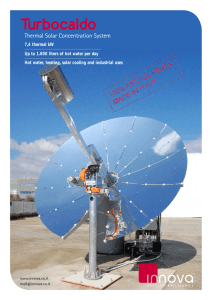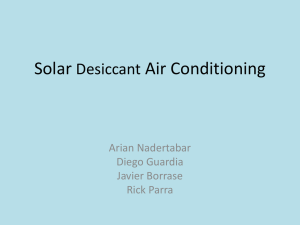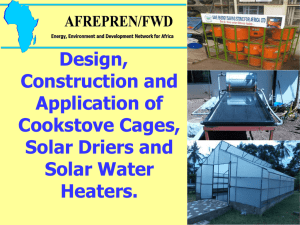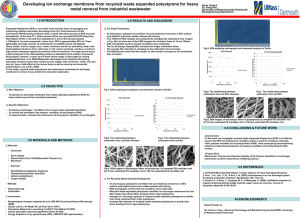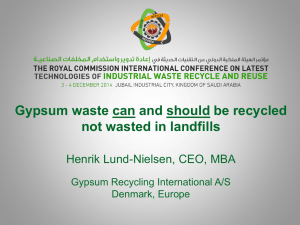Document
advertisement
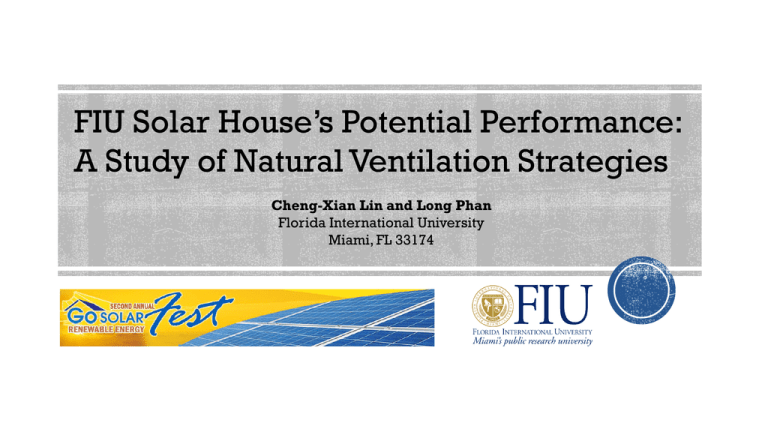
FIU Solar House’s Potential Performance: A Study of Natural Ventilation Strategies Cheng-Xian Lin and Long Phan Florida International University Miami, FL 33174 10 Contests • • • • • • • • • • Architecture Dwelling Documentation Communications Comfort Zone Appliances Hot Water Lighting Energy Balance1 Getting Around Modular construction An overview of the house At a glance Name: Engawa Constructed by modules 1/3 glass PV-integrated windows (projection surface) • Overall standing 13/18 • • • • FIU Solar House’s demonstration The house exhibition 1 All credits to DOE Solar Decathlon (www.solardecathlon.gov) & FIU solardecathlon (http://gsl.eng.fiu.edu/webs/SOLAR2004/) 10 Contests • • • • • • • • • • Architecture Market Appeal Engineering Communications Affordability Comfort Zone Hot Water Appliances Entertainment Energy Balance1 Aerial view Overview of the house model At a glance • • • • • Visitors at the exhibition in Washington D.C. Rooftop solar panels Name: perFORM[D]ance Modular design Open pavillion Operable louvers/shade Overall standing: 11/22 Exterior & interior Top view of the house model All credits to DOE Solar Decathlon (www.solardecathlon.gov) & FIU solardecathlon (www.solardecathlon.fiu.edu) 2 10 Contests • • • • • • • • • • Architecture Market Appeal Engineering Communications Solar Application3 Comfort Zone1 Hot Water1 Appliances Entertainment Energy Balance1 At a glance • • • • • Overview of the house model Name: O-house Modular house PV louvers Traditional courtyard Overall standing: 5/22 Interior Rooftop solar panels All credits to Solar Decathlon China (http://www.sdchina.org/) & FIU-Tsinghua team(http://www.thfisdc.com/) 3 Public Exhibition and Educational Activities Outreach: Annual Engineering Expo, Engineers on Wheel Visiting by students: undergraduate and K-12 Lab tours Student Projects Senior design projects Course projects Exchange student studies Elise Belleil, EI. CESI, France, Summer 2013 Francisco Zevallos, Loughborough/Northumbria University, UK, Fall 2013 Research Projects Real time temperature and humidity monitoring PV/T technology demonstration Building energy simulation model validation 4 The Solar House Model 34’4” x 25’4” x 15’4” 7 typical residential spaces Total conditioned area 721.15 ft2 Window-to-wall ratio is 45.8 % Rooftop PV panels with tilted angle of 75o Floor plan of the house 5 The benefits of natural ventilation strategies The limitations and remedies of energy utilization in hot and humid climates The aid of building energy simulation program providing insights for different strategies Comparisons of a few natural ventilation strategies to seek the most possible solution in terms of thermal comfort and energy reduction 7 Wall and window areas in different surfaces (ft2) Gross Wall Area Window Opening Area (ft2) Gross Window-Wall Ratio (%) Total 1682 North 500.41 East 449.18 South 283.09 West 449.18 764.99 360.59 202.25 0 202.25 45.48 72.06 45.03 0.00 45.03 Typical rooms of the solar house Room Type Area (ft2) Volume (ft3) Dining room Living room Bedroom Bathroom Study room Kitchen Battery room Mechanical room 120.56 135.63 135.63 78.79 88.48 162.43 19.48 1,297.11 1,869.21 1,869.21 718.30 986.34 1,655.90 30.10 407.53 Conditioned (Y/N) Y Y Y Y Y Y N N Electrical Load (W) 0 1,050 840 5,340 60 8,964 - Lighting Load (W/ft2) 1.8 1.8 1.8 1.8 1.8 1.8 - The 2005 solar house model 8 Energy Balance Equation for a room model 𝑑𝑇𝑧 𝐶𝑧 = 𝑑𝑡 𝑁𝑠𝑢𝑟𝑓𝑎𝑐𝑒𝑠 𝑁𝑠𝑙 𝑄𝑖 + 𝑖=1 𝑁𝑧𝑜𝑛𝑒𝑠 ℎ𝑖 𝐴𝑖 𝑇𝑠𝑖 − 𝑇𝑧 + 𝑖=1 𝑚𝑖 𝐶𝑝 𝑇𝑧𝑖 − 𝑇𝑧 + 𝑚𝑖𝑛𝑓 𝐶𝑝 𝑇∞ − 𝑇𝑧 + 𝑄𝑠𝑦𝑠 𝑖=1 Net Zone Load 𝑁𝑠𝑢𝑟𝑓𝑎𝑐𝑒𝑠 𝑁𝑠𝑙 𝑄𝑙𝑜𝑎𝑑 = 𝑄𝑖 + 𝑖=1 𝑁𝑧𝑜𝑛𝑒𝑠 ℎ𝑖 𝐴𝑖 𝑇𝑠𝑖 − 𝑇𝑧 + 𝑖=1 𝑚𝑖 𝐶𝑝 𝑇𝑧𝑖 − 𝑇𝑧 + 𝑚𝑖𝑛𝑓 𝐶𝑝 𝑇∞ − 𝑇𝑧 𝑖=1 System Load Equation 𝑄𝑠𝑦𝑠 = 𝑚𝑠𝑦𝑠 𝐶𝑝 𝜂 𝑇𝑠𝑢𝑝 − 𝑇𝑧,𝑑𝑒𝑠𝑖𝑟𝑒𝑑 Simulation Code: EnergyPlus 9 Miami, FL climate graph Int. Door Layer 1 Layer 2 Layer 3 Layer 4 Layer 5 Wood Ext. Door Metal surface Ext. Windows Roof Floor Ext. Wall Int. Wall Clear glass Plywood Metal surface Gypsum board Insulatio n board Air resistance Polystyrene (Extruded) Steel frame Polystyrene (Extruded) Polystyrene (Molded beads) Cellular Polyisocyanurate Gas permeable facers Steel frame Polystyrene (Molded beads) Polystyrene (Molded beads) Gypsum board Steel frame Polystyrene (Molded beads) Gypsum board Clear glass Plywood Gypsum board Steel frame 10 (b) (a) Natural ventilation methods (a) (b) (c) (d) (c) Thermal chimney (TC) Earth tube (ET) Cool tower (CT) Opening (d) 11 (a) Annual energy consumption (b) Total uncomfortable days Comparison among various natural ventilation systems 12 Hybrid system schedule Comparison among various hybrid cooling systems (a) Annual energy consumption (b) Total uncomfortable days 13 Comparison among all cooling systems 14 Temperature profile of 7 thermal zones at different cooling strategies 15 Various natural ventilation strategies including earth tube, thermal chimney, wind tower, and opening, as well as hybrid strategies are investigated. Relying on only natural ventilation could cause a dramatic impact to the human thermal comfort. Hybrid systems have revealed the significant reduction in cooling energy consumption while complying with the minimum requirements for thermal comfort recommended by ASHRAE standards. Combined thermal chimney and mechanical system (HVAC) method shows relatively better potentials for hot and humid climate such as Miami. 16



